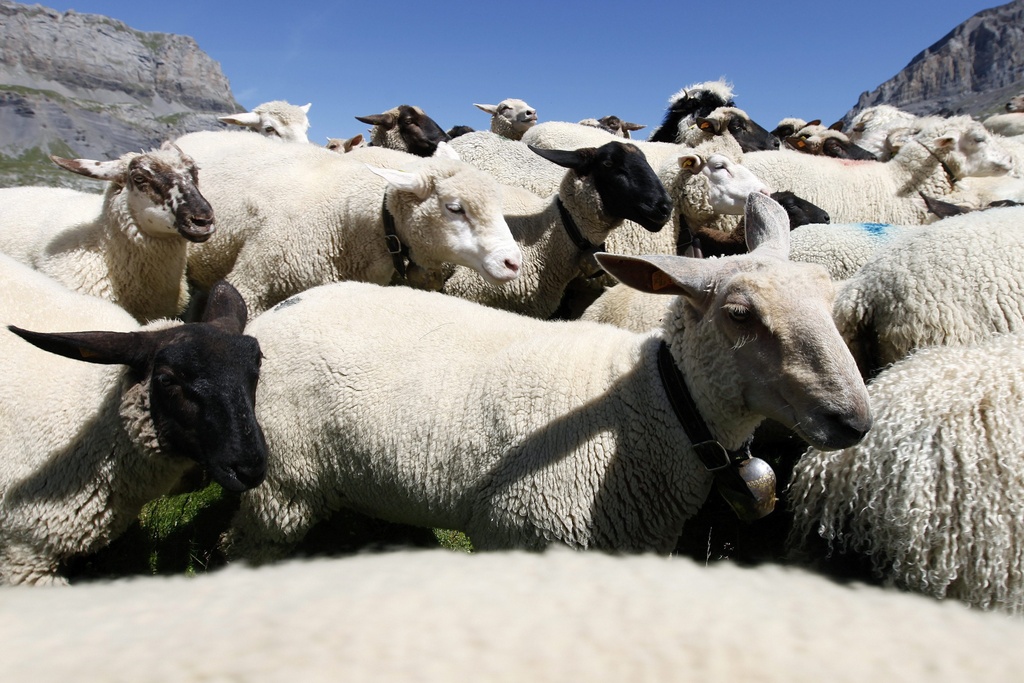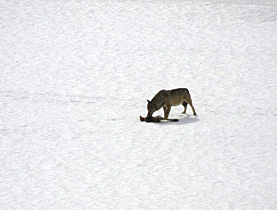Swiss design anti-wolf collar for sheep

Alpine wolves may soon be running scared from Swiss mountain sheep if a new high-tech protection collar manages to reach the production line.
A Swiss student and a well-known wolf expert have joined forces to start developing a device that can monitor a sheep’s pulse and then release a powerful repellent to scare off a predator in the event of an attack.
“Our project is still in its preliminary phase,” explained Fabien Matter, a student of infotronics [analogue and digital electronics, combined with computer technology] at the University of Applied Sciences for Western Switzerland, based in Sion, canton Valais.
“But we should have a first prototype collar in March 2011 that can set off a repel system due to higher cardiac activity,” the 28-year-old engineering student told swissinfo.ch.
The experimental protection device works by monitoring a sheep’s pulse and checking when it gets too high, resulting from the stress of a wolf attack.
The precise detection method still needs to be properly validated, but Matter says he is considering a number of ways of measuring a sheep’s pulse electronically.
This could be done using an optical technique to shine light at the sheep’s heart and measuring light intensity variations, which correspond to heartbeats. Electrocardiography, using sensors to measure the heart’s electrical activity, ultrasound, or microphones will also be considered in the early testing phase, according to the student.
When the pulse gets too high, the collar will then activate a system to scare away the predator – high-frequency ultrasound waves that the wolf can hear but not the sheep, bright flashing lights or a blast of bear repellent pepper spray.
Such repellent methods also still need to be properly tested, said Matter.
Satisfy both camps
The student said he got the idea for the collar following a televised debate earlier this year regarding the presence of wolves in Switzerland and their authorised shooting by cantons.
“As an ecologist, I wanted to find a solution that satisfied both the pro- and anti-wolf parties,” he told swissinfo.ch.
It is thought there may be up to 20 wolves in Switzerland and the number is likely to rise. The protected predator enjoys national support, but periodic attacks on livestock and growth in numbers are causing alarm among certain farmers and mountain communities.
In mid-August in the Montana-Varneralp area in canton Valais a wolf which had been suspected of attacking livestock was shot. Environmental group WWF complained, saying the problem of the wolf could not be solved with a rifle, and more livestock protection methods were needed.
After the debate a cantonal vet put Matter in touch with wolf expert Jean-Marc Landry, who was instantly seduced by the young student’s idea and decided to collaborate. He will investigate the repellent aspect by studying wolves in captivity over the coming months and will also look into the stress levels experienced by sheep during an attack.
Totally traumatizing
The team want to try to teach the wolf to stay away from sheep, goats and cattle to concentrate on game living in the mountains.
“The Americans have done lots of tests with collars where the wolf has to reach its prey to set off a system, but they haven’t taken into account the learning process,” Landry told Le Matin Dimanche newspaper.
The wolf is like a human and remembers bad experiences like touching an electric fence, he explained.
“The first contact between the wolf and this collar must be totally traumatising,” said Landry, who has helped advise the government on the “Swiss Wolf Project”.
According to the specialist, an experiment in Georgia also showed that the predator passes its fear onto its cubs and therefore to subsequent generations.
The collar offers an interesting alternative to the traditional mountain guard dogs, he added.
“A wolf is not really afraid of guard dogs,” he said. “On small high mountain pastureland like in Valais, it’s expensive to have dogs and a shepherd permanently.”
Christine Cavalera, a specialist at canton Valais’s agriculture department who is due to examine the proposal with the team, said as a first impression it was an interesting solution, as it could offer farmers an additional protection method.
But a number important questions were still open, she added, such as the impact of the device on guard dogs and whether the problem would be shifted from sheep onto other animals.
A finished version of the collar, which can also be adapted for cattle, could be available by autumn 2012 and would cost between SFr50-100, say the team.
Wolves gained “strictly protected” status in Europe under an international agreement after being driven to extinction in the 19th century, largely by hunting and the expansion of human settlements. They started to return to Switzerland about ten years ago from neighbouring Italy and have begun colonising again.
Their diet mostly includes stags (30%), deer (21%), goats (12%), sheep (12%), ibex, chamois and wild boar (5%) and cattle (2.5%). They generally live high up in the mountains and don’t attack sheep if they have other things to eat and if the sheep are protected by guard dogs.
The government’s “Swiss Wolf Project” was drawn up in 2001, with revisions later added permitting the shooting of any wolf believed to have killed at least 35 sheep over a four-month period, or 25 in a single month. Farmers are reimbursed for any animals killed by a wolf and receive financial support for prevention measures.
Since 2000 official cantonal authorisation to kill a wolf has been given 12 times and seven wolves have been shot dead. The penalty for illegally killing a wolf is up to one year in prison and a fine.

In compliance with the JTI standards
More: SWI swissinfo.ch certified by the Journalism Trust Initiative














You can find an overview of ongoing debates with our journalists here . Please join us!
If you want to start a conversation about a topic raised in this article or want to report factual errors, email us at english@swissinfo.ch.